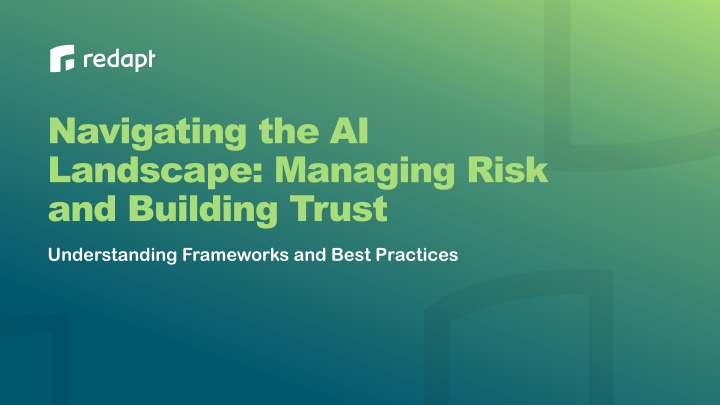
Managing Risk in AI Deployment: Frameworks & Best Practices
Learn about the importance of ethical frameworks in AI deployment to manage risks like biased datasets, security vulnerabilities, and compliance issues. Explore best practices and additional frameworks such as AI RMF, RAFT, NeMo Guardrails, and TRiSM for building trust and ensuring secure AI adoption.
Download Presentation

Please find below an Image/Link to download the presentation.
The content on the website is provided AS IS for your information and personal use only. It may not be sold, licensed, or shared on other websites without obtaining consent from the author. If you encounter any issues during the download, it is possible that the publisher has removed the file from their server.
You are allowed to download the files provided on this website for personal or commercial use, subject to the condition that they are used lawfully. All files are the property of their respective owners.
The content on the website is provided AS IS for your information and personal use only. It may not be sold, licensed, or shared on other websites without obtaining consent from the author.
E N D
Presentation Transcript
Navigating the AI Landscape: Managing Risk and Building Trust Understanding Frameworks and Best Practices
The Need for a Framework Not in a sci-fi doomsday sense, but potential areas that can disrupt or severely damage organizations diving into the technology without being cautious. The risks of AI include: Ethical concerns, such as fake content, misinformation, plagiarized material, and so on Biased datasets that perpetuate and amplify societal biases, which can result in unfair or discriminatory outputs Vulnerabilities that allow bad actors to circumvent security measures, such as convincingly worded phishing emails or the bypassing of authentication systems Running afoul of compliance and other regulations governing privacy, as well as property rights and consumer protections To avoid these and other potential pitfalls, organizations need to follow several best practices that have already been established, beginning with the adoption of an ethical framework.
Adopting an Ethical Generative AI Framework While adopting an ethical framework is an important first step, it s not a complete solution. To fully deploy and utilize generative AI ethically, organizations must also focus on developing: Diverse and representative data sets that have been validated and preprocessed to identify and address bias Security protocols like encryption, access controls, and regular security audits to protect generative AI systems from unauthorized access Human oversight and review of AI workflows to validate outputs, identify errors, and intervene in cases of ethical or legal concerns Ongoing monitoring and evaluation of performance to detect and address emerging issues Focusing on developing each of these takes time, resources, and expertise three things many organizations don t have in overabundance. But they are also the bare minimum of what needs to be in place before the adoption and employment of generative AI.
Additional Frameworks AI Risk Management Framework (AI RMF): Spurred by the National Institute of Standards and Technology (NIST), AI RMF is an exhaustive playbook for AI usage, detailing the risks of the technology, how to prioritize those risks, and best practices for risk management. RAFT: Developed by Dataiku, RAFT expands upon the baseline set of values for safe AI adoption. Its aim, according to the organization, is to serve as a starting point for your organization s own indicators for Responsible AI. NeMo Guardrails:An open-source software provided by NVIDIA, Nemo Guardrails assists developers in creating boundaries for applications powered by large language models (LLMs), such as chatbots. TRiSM: A newer entry into the AI framework, TRiSM (which stands for Trust, Risk, and Security Management) is designed to: Ensure the reliability, trustworthiness, and security of AI models. Drive better outcomes from AI adoption. Provide a set of solutions for building protections into AI delivery and governance.
Your Partner in Responsible AI Like any new technology, generative AI needs to be handled deliberately and with purpose. That means doing more than just the bare minimum to ensure its ethical usage. To avoid the inherent risks of generative AI risks that are easy to gloss over in a dash to adopt the technology it s important for organizations to apply best practices as they continue to evolve. At Redapt, we consistently help organizations of all sizes apply frameworks for ethical generative AI. And beyond frameworks, we also work with organizations on four key areas: 1.Assessment of generative AI systems to evaluate their trustworthiness, transparency, reliability, and accountability metrics 2.Analysis of ethical impacts to identify potential risks and harms associated with generative AI deployment and inform strategies for responsible deployment 3.Development of a safety-by-design approach to integrate safety considerations into the creation of generative AI systems, including robust testing, validation, and monitoring protocols, as well as fail-safe mechanisms to prevent catastrophic failures 4.Fosteringa culture of continuous learning and improvement in AI development teams, emphasizing the importance of ongoing research, experimentation, and knowledge sharing
Lets Build a Responsible AI Future Together Are you looking to adopt generative AI in your organization? Together, we can discuss your organization's AI goals and challenges and explore how we can help you navigate the AI landscape.
